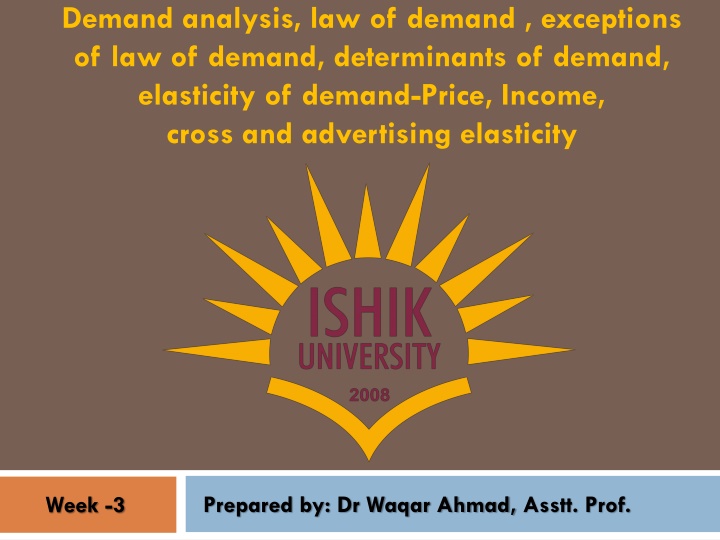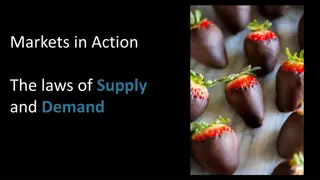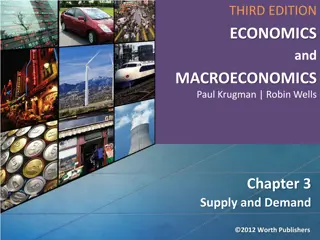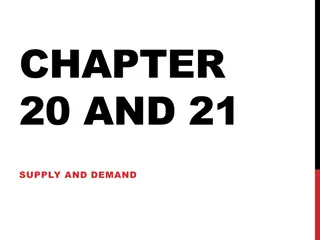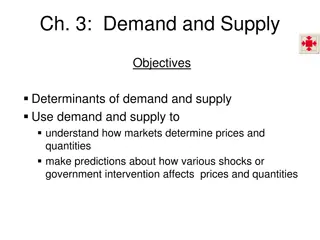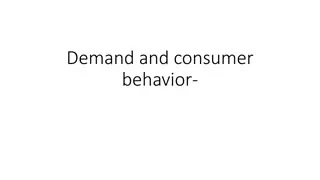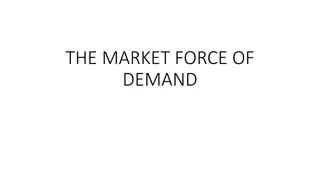Demand Analysis: Law and Determinants
In the study of demand analysis, explore the law of demand, exceptions, determinants, and elasticity in relation to price, income, cross, and advertising. Understand the factors influencing consumer behavior and market trends. Dive into the complexities of demand dynamics and its impact on pricing strategies.
Download Presentation

Please find below an Image/Link to download the presentation.
The content on the website is provided AS IS for your information and personal use only. It may not be sold, licensed, or shared on other websites without obtaining consent from the author.If you encounter any issues during the download, it is possible that the publisher has removed the file from their server.
You are allowed to download the files provided on this website for personal or commercial use, subject to the condition that they are used lawfully. All files are the property of their respective owners.
The content on the website is provided AS IS for your information and personal use only. It may not be sold, licensed, or shared on other websites without obtaining consent from the author.
E N D
Presentation Transcript
Demand analysis, law of demand , exceptions of law of demand, determinants of demand, elasticity of demand-Price, Income, cross and advertising elasticity Prepared by: Dr Waqar Ahmad, Asstt. Prof. Week -3
Learning Objectives 2 1.Demand and law of demand 2.Law of demand 3.Exceptions of demand 4.Determinants of demand 5.Elasticity of demand and its types Week-2 2/16/2025
What is demand ? 3 Willingto Purchaseat VariousPrices duringPeriod ofTime Ableto Purchaseat VariousPrices duringPeriodof Time Week-2 2/16/2025
Definitions of Demand Demand refers CommoditythattheConsumersareAbleto BuyateachpossiblePriceduringa givenPeriodofTime,otherthingsbeing equal. to the Quantities of By:Ferguson DemandistheAbilityandWillingness tobuySpecificQuantityofaGood atAlternativePricesinagivenTime Period,CeterisParibus. By : B. R. Schiller 3
Determinants of Demand 5 Price of the Commodity Price of Related Commodities Level of Income of the Household Taste & Preferences of Consumers Other Factors Week-2 2/16/2025
Determinants of Demand 6 PriceoftheCommodity Ceterisparibusi.e.Other BeingEqual, Things 1 P D ThisHappensBecauseofIncome& SubstitutionEffect.
Determinants of Demand PriceofRelatedCommodities ComplementaryGoodse.g.Pen&Ink PriceofoneGood DemandofOtherGood SubstitutingGoodse.g.Tea&Coffee PriceofoneGood DemandofOtherGood 6
Determinants of Demand LevelofIncomeoftheHousehold AverageMoneyIncome QuantityDemandedofaGood Exception:InferiorGoods AverageMoneyIncomeQuantity DemandedofaGood 7
Determinants of Demand 9 Taste & Preferences of Consumers Other Factors Size of the Population Composition of Population
Law of Demand 10 LawofdemandstatesthatPeoplewillBuy moreatLowerPricesandBuylessat HigherPrices,Ceterisparibus,orother thingsRemainingtheSame. By:Samuelson TheLawofDemandstatesthat QuantityDemandedIncreaseswithaFall inPriceandDiminisheswhenPrice Increases,otherthingsbeingequal. By:Marshall
AssumptiontoLawofDemand LawofdemandholdsGoodwhen Other ThingsRemaintheSame meaningthereby,the factorsaffectingdemand,otherthenprice,are assumedtobeconstant. DemandFunction:Dx=f(PX,Pr,Y,T,E) where, Dx=DemandforCommodity Px=PriceofCommodityX Pr=PriceofOtherGoods Y =IncomeoftheConsumer T =Tastes E =ExpectationoftheConsumer 10
Explanation 12 According to Law of Demand, Ceteris Paribus Quantity Demanded Price 1 However, thisRelationisnotProportional, meaning therebythatitisnotnecessary thatwhenPrice Fallsby , DemandforGoodswillbeDoubled. ThissimplyindicatestheDirectionofChange inDemandasa result of change price
Demand Schedule 13 Demand QuantitieswhichConsumerwouldliketo BuyperunitofTimeatDifferentPrices. TwoAspectsofDemandSchedule IndividualDemandSchedule MarketDemandSchedule Schedule is a Series of
Individual Demand Schedule Priceperunit (inRs.) Quantity Demanded (Units) It is defined as a Table which shows Quantities of a Given Commodity which an Individual Consumer will buy Possible Prices at a given Time. 1 4 2 3 at all 3 2 4 1 13
Market Demand Schedule It is defined as the Quantities of a Given Commodity which all Consumers will buy at all Possible Prices at a given Moment of Time. In Market there are many Consumers of a Single Commodity. The Schedule is based on the Assumption that there are in all, 2 Consumers A & B of Commodity X . By aggregating their Individual Demand, the Market Demand Schedule is constructed. 14
Priceof Commodity X (inRs.) Demandof A Demandof B Market Demand (Units) 4+5=9 1 4 5 2 3 4 3 2 1 4 3 2 3+4=7 2+3=5 1+2=3 Itindicatesthatwhenpriceof X isRs 1.00perunit,Demandof A isfor4unitsand thatof B isfor5units.ThustheMarket Demandis9units.AsthePriceIncreases, Demand Decreases. 15
Demand Curve ADemandCurveisaLocusof PointsshowingvariousAlternative Price-QuantityCombinations. ItshowstheInverseRelationship betweenPrice&QuantityDemanded. ItSlopesDownwardstotheRight. 16
Individual Demand Curve X XAxis Price(.)Y Axis QuantityDD DemandCurve D 4 The demand curve slopes downwards from left to right meaning thereby that when price is high demand is low and vice versa. 3 Price 2 1 D 0 1 2 3 4 Quantity
Market Demand Curve Y D 4 Price 3 2 1 D X 0 3 5 7 9 Quantity 18
WhydoesDemandCurve SlopeDownward? 20 Income Effect:ItistheEffectthataChangeina Person sRealIncomecausedbyChangeinthe PriceofaCommodityhasontheQuantityofthat Commodity.Inotherwords,theIncrease inDemandonAccountofIncreaseinRealIncome isknownasIncomeEffect. Substitution Effect:ItistheEffectthataChange inRelativePricesofSubstituteGoodshason theQuantityDemanded.SubstitutesareGoods thatcanbeusedinplaceofeachother.
WhydoesDemandCurve SlopeDownward? 21 Different Commoditieswith tends to Extend Consequent uponthe allintheirprices. Size of Consumer Group:Whenthe PriceofaCommodityfalls,then manyConsumers,whoareunableto buythatCommodityatitsPrevious Price,ComeForwardtobuyit. Uses: Demand for AlternativeUses
22Exceptions to Law of Demand Article of Distinction or Veblen Goods:Goods likeJewellery,Diamonds&Gemsare consideredasArticlesofDistinction.These GoodscommandMoreDemandwhen theirPricesareHigh. Ignorance:Manyatime,Consumersout ofsheerIgnoranceorPoorJudgment consideraCommoditytobeofLowQualityif itsPriceisLowandofHighQualityifitsPrice isHigh.
23Exceptions to Law of Demand Giffen Goods:GiffenGoodsarethoseInferior GoodswhoseDemandfallsevenwhen theirPricesFalls.Forexample, Bajra .Only thoseInferiorGoodsarecalledGiffen GoodswhereLawofDemandFails. Expectation of Rise or Fall in Price in Future:If PricesarelikelytoRiseMoreintheFuture thenevenattheExistingHigherPrice peoplemayDemandmoreUnitsofthe CommodityinthePresentandviceversa.
Expansion & Contraction in Demand 24 Price , QD DownwardMovement AlongtheDemand Curve Expansion Price , QD UpwardMovementAlong theDemandCurve Contraction
Expansion & Contraction in Demand 25 Y D P`` ofDemandContraction Price P Expansion of Demand P` D X O N L M QuantityDemanded
Increase & Decrease in Demand 26 PriceSame, QD due to Change in Other Factors Rightward Shift Increase PriceSame, QD due to ChangeinOtherFactors LeftwardShift Decrease
Increase & Decrease in Demand 27 Increase in Demand Decrease in Demand D D` D` D Price Price D` D D D` Quantity Demanded Quantity Demanded
DistinctionbetweenExtension& IncreaseinDemand Extension in Demand meansRiseinDemand in Response to fall in the Price Increase refers to the Rise in in Demand Demand in Response to theChangeinthe Determinants Demandother Price. Itisexpressedbythe UpwardShiftofthe EntireDemandCurve. of a Commodity, thingsbeingequal. Itis expressed by the Movement a Higher Pointto Lower Point along the Other ofthen from a same Demand Curve 27
Distinction between Contraction & Decrease in Demand ContractioninDemand meansFallinDemand in Response to a Rise in the Price of a Decrease in Demand meansFallinDemand inResponsetoChange in Determinantsof Demand,Other thePrice. Itisexpressedby aDownwardShiftof theEntireDemand Curve. Commodity,Other thingsbeingEqual. It is expressedby the Movement Lower Higher Pointon then from a a Pointto the Same Demand Curve 28
Elasticity of Demand 30 It answers the Question BY HOW MUCH? Elasticity of Demand ResponsivenessoftheQuantityDemandedofa GoodtoChangeononeoftheVariableson whichDemandDepends. is defined as the E = % Change in Q.D. % Change in one of the Variables on which Demand depends
Types of Elasticity of Demand 31 Price Elasticity Income Elasticity Cross Elasticity GeneralEconomics:Lawof DemandandElasticityof Demand
Price Elasticity of Demand 32 ItisMeasuredasaPercentageChangeinQuantity DemandedDividedbythePercentageChangein Price,OtherthingsRemainingSame. % Change in Q.D. Ep = % Change in Price Ep =Change in Quantity Change in Price Original Quantity Original Price
Price Elasticity of Demand Q P P Where, Ep P Q 33 E p = Q PriceElasticity VerySmallChange Price QuantityDemanded Note:Epis(-)veduetoInverseRelationship BetweenPrice&QuantityDemanded.
DegreesofPriceElasticityof Demand 34 More thanUnit Elastic (Elastic) E > 1 Lessthan Unit Elastic (Inelastic) E < 1 Perfectly Elastic E= Perfectly Inelastic E=0 Unit Elastic E=1
Perfectly Elastic Demand A Perfectly Elastic Demand is one in which a Little ChangeinPricewillCause anInfiniteChange inDemand. AverylittleRiseinPrice causestheDemandtoFallto ZeroandaverylittleFallin Price causes ExtendtoInfinity. Under Perfect Competition, DemandCurveofaFirmis Y 6 E = infinite 4 D D Price (IQD.) Demand to 0 10 20 30 X Quantity PerfectlyElastic. 34
Perfectly Inelastic Demand Perfectly Demand which Price Change QuantityDemanded. Inthiscase,Elasticity ofDemandisZero. Inelastic isonein aChangein Produces in Y D E = 0 6 Nothe Price (IQD) 4 2 D 0 2 4 6 X Quantity 35
Unitary Elastic Demand UnitaryElastic which a % Change in PriceProducesan Equal%Changein Demand. Thistypeof demand Curve iscalled Hyperbola. Y D P Price (Rs.) (%) E = 1 D T X O M Quantity (%) N 36
Greater than Unitary Elastic Y Greater than Unitary elastic demand is one in which a given ^ change in price produce relatively change in demand D P E>1 Price (Rs.) (%) T D more % In this case elasticity of demand is greater than unitary. X O M N Quantity (%) 37
Less than Unitary Elastic Less Elastic Demand is one inwhich Change Produces Less% Change demand Inthiscase,Elasticity ofDemandisLessthen Unitary Y than Unitary D a given % in Relatively P Price (Rs.) (%) E< 1 Price in T D X M N O Quantity (%) 38
Point Elasticity of Demand ReferstoMeasuringtheElasticityataParticular PointonDemandCurve. MakesUseof DerivativeChanges thanFiniteChangesinPrice&Quantity. DefinedAs: dq dp Rather p q dq Where,dpis the derivative of Quantity w.r.t. Price at a point on demand curve. 39
Point Elasticity of Demand PointElasticity=UpperSegment LowerSegment Y E= M P M PN E>1 = A Price (Rs) E =1 AsweMovefrom NtoM,Elasticity GoesonIncreasing. AtMidPoint,Ep=1, atNEp =0&atMEp= P E<1 B Mid Point E =0 X O N Quantity 40
Arc Elasticity of Demand When Elasticity is to be found between 2 Points, Y Arc Elasticity we use Arc Elasticity. Elasticity=q1 q2 p1+ + p2 q1+ + q2 Where, p1= Original Price q1= Original Quantity p2= New Price A P1 Price (Rs) B p1 p2 P2 X Q1 Q2 O Quantity q = New Quantity 2 41
Arc Elasticity of Demand 43 For Example, Find Elasticity of Radios Between: p1=Rs.500 p2=Rs.400 q1= 100 q2= 150
Total Expenditure (Outlay) Method 44 ThisMethodwasevolvedbyDr.Alfred Marshall. AccordingtothisMethod,ToMeasurethe ElasticityofDemanditisEssential toKnowHowMuch&InWhatDirection theTotalExpenditurehasChangedasa ResultofChangeinthePriceofaGood.
Total Expenditure (Outlay) Method 45 Elasticityof Demand Total Price Expenditure Greaterthan Unityi.e.Ep>1 SameSame Unchanged Unity i.e.Ep=1 Unchanged LessthanUnity i.e.Ep<1
Total Expenditure (Outlay) Method Y T A E>1 R B Price (Rs.) N E=1 M C E<1 P E D X O Total expenditure 45
DeterminantsofPriceElasticityof Demand 47 AvailabilityofSubstitutes Positionof Commodityin Consumer s Budget NatureofNeedthataCommoditySatisfies NumberofUsestowhichaCommodityis Put Period ConsumerHabits
Income Elasticity of Demand 48 IncomeElasticityofDemandistheDegreeof ResponsivenessofQuantityDemandedofa GoodtoaSmallChangeintheIncomeof Consumer. %ChangeinQuantityDemanded Ey= %ChangeinIncome
DegreesofIncomeElasticityof Demand 49 Positive Income Elasticity of Demand - Unitary Income Elasticity of Demand - Less than Unitary Income Elasticity of Demand - More than Unitary Income Elasticity of Demand Negative Income Elasticity of Demand Zero Income Elasticityof Demand
Positive Income Elasticity of Demand Y Income Elasticityof Demand for a Good when with and increase of a consumer his demand for the good increase ad vice versa ItisPositiveincaseof NormalGoods. is positive, DY A Income B DY X O Q Q 49 Quantity
